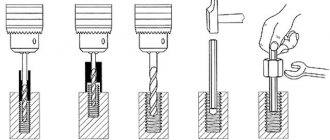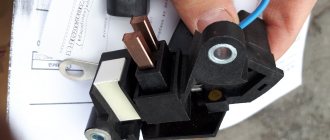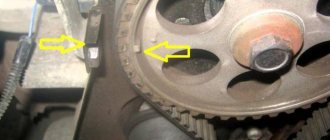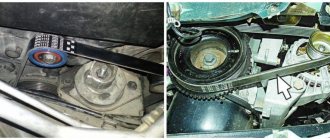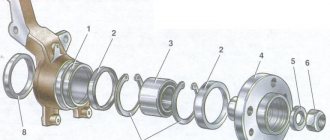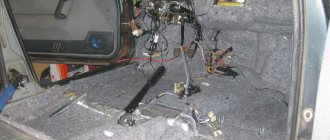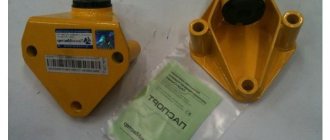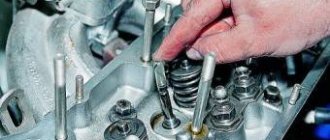Methods for disassembling threaded connections at home
There is a whole set of folk methods for unscrewing a stuck nut. But it doesn’t always work out the first time, you have to tinker. Unscrewing a rusty bolt is not so easy. But with experience comes skill, when rust on fasteners no longer scares you. There is no universal method; each specific case requires an individual approach.
Warming up
Plumbers, who always have a gas welder in their team, like to use this method. The problematic connection is heated with a gas burner. The nut increases in size due to thermal expansion. The thread also weakens. It becomes easier to unscrew the hardware.
But this method does not always work. Then the capricious unit continues to be heated further. As the temperature rises, and the bolt heats up along with the nut, the rust begins to burn off, freeing the threads. If the old fastener is intended to be used further, it should be unscrewed only after it has cooled down.
These methods, as life has shown, are very effective, but not every home craftsman has a gas burner, so you have to resort to other methods. For example, heat using a blowtorch or a hair dryer.
Tapping
One of the oldest methods is to tap the threaded joint with a hammer. Impacts create vibration, which promotes cracking and peeling of rust. In advanced cases, this is unlikely to work, but if corrosion processes have begun recently, disassembling the connection is quite possible.
Welding
An effective method is to weld a larger nut to the head of the bolt. For example, if the rusted hardware has an M16 thread, then an M24 nut attached to it by welding will allow you to use a more powerful wrench and extension for the job. In this case, due to the increase in leverage, less significant effort is applied.
Jerking
You can move the fasteners from their place with a sharp jerk of the key. It is better to use an extension cord. If it doesn’t work on the first try, try moving in the opposite direction - twisting. Then repeat these two steps.
This method is called loosening and in some cases it helps. Especially if you first lubricate the assembly with an appropriate product and leave it for several hours.
Traditional lubricants and solvents
To make it easier for themselves to unscrew stuck nuts and bolts, many craftsmen use various chemical liquids. Pre-wetting the problem area makes the task much easier.
For this you can use:
- kerosene;
- petrol;
- alcohol;
- iodine;
- table vinegar;
- carburetor cleaner;
- brake fluid;
- WD-40 product.
Even Coca-Cola will do. The rusted area is lubricated with liquid using a brush, but even better is to moisten a rag with the product and wrap the fasteners, leaving it for at least two hours, preferably for a day. The exception is WD-40. It is simply sprayed from a can onto the rust. After waiting time, they try to unscrew the hardware. In most cases, the attempt is successful.
If the result is negative, any acid can be used. To do this, a cup with a height slightly larger than the hardware is molded from beeswax or plasticine around a rusty nut (bolt). Acid is poured there and a piece of zinc is placed. This results in a galvanic couple. Acid destroys rust, and zinc restores iron cations.
This method allows you to unscrew the assembly without damaging the parts with acid, but it is only applicable if the fastener is located vertically in the upper position.
Warming up
You should try to achieve the desired result by heating the capricious fasteners. Everything will do here - a gas torch, a soldering iron, a pocket lighter. You can even use rags soaked in gasoline or other flammable liquid, but this should be done carefully, following safety rules. Without waiting for the old nut or rusty bolt head to cool down, you need to try to unscrew them. The best choice for these purposes is not an open-end wrench, but a box or socket wrench. If you don’t succeed the first time, you can try combining techniques - tapping well, loosening, using a lever.
How to unscrew a broken bolt?
Basic methods:
- Clean the surface with a metal brush and treat it with diesel fuel or kerosene. They try to unscrew the nut with a spanner. Although there is no absolute guarantee that it will unscrew.
- Using a chisel and hammer, strike in the direction of unscrewing. This method is not suitable for a small nut.
- A gas wrench with a powerful clamp is a good tool in this situation. It is easy for them to grab even round objects, but it is harder in hard-to-reach places. The longer the handle, the easier it is to unscrew.
- When the fastening material is large and difficult to unscrew, you can use welding equipment to apply a metal coating and prepare the desired turnkey shape with a file.
- Use a drill to cut out a hole inside the body of the fastening element, thread an L-shaped rod through it, which will serve as a handle, and remove it.
When there is enough space to use an adjustable wrench or pliers, this is good, but what to do in other situations?
How to unscrew a hex or sprocket head bolt
To remove the element, use a gas wrench to compress the part, make a cut on the head with a grinder and unscrew it with a screwdriver, an extractor of the appropriate size, or special tools (wrench, pin driver), which are beneficial to purchase only if you have to deal with such problems quite often.
Select the TORX sprocket according to size (it should not be large and the slots should fit into the hole for the hexagon). It is inserted tightly into the head and the bolt is jerkily unscrewed to avoid the sprocket spline from breaking off. When driving sprockets with holes in the center, they break off, so their use is not recommended.
Any hardware or auto store sells sets of extractors. Externally, this device looks like a metal rod with a conical thread on the left side and a faceted base on the right. They are used to unscrew nuts with torn edges. To do this, drill a hole strictly in the center of the bolt, drive an extractor of the required size into it and unscrew it with pliers. This is done simply and quickly, because the extractor has the opposite cutting.
A drill with reverse is an irreplaceable thing. Use a thin drill to make a hole near the bolt. Take a left-hand rotation drill with a smaller diameter and drill out the damaged bolt in inverse rotation mode.
WD-40
“Spray it with Vedashka” - this is how any garage will respond to a complaint about a problematic bolt or capricious nut. And they will be absolutely right. A better remedy has not yet been invented. Its exact recipe remains a mystery, but it is known for certain that the liquid consists of 50% white spirit. To unscrew soured fasteners, you first need to open access to the threads by treating the area around the bolt or nut with a wire brush, and then generously fill the fasteners with “magic” liquid, spraying it from a spray can. After 15-20 minutes you can try to unscrew it. This remedy is really effective and almost always helps.
Methods for unscrewing soured bolts
Car enthusiasts, who most often have to deal with stuck bolts, know how to unscrew a soured bolt. Several methods of unscrewing are used, including the use of physical and temperature effects, and chemical compounds.
Tapping and physical impact
Impact with a hammer and chisel helps to disrupt the adhesion of materials and corrosion, as a result of which the bolt gives way and is unscrewed.
Tapping. A preparatory activity that helps destroy oxides. In mild cases, after tapping it is possible to unscrew the hardware. It is enough to hit the fastener 2-3 times with a hammer using a copper adapter. Loosening. Like tapping, it is aimed at destroying rust. You should not unscrew, but rather tighten the bolt even tighter, and only then try to unscrew it. Lever arm. It is recommended to use it as a key tool at hand. First you should clean the hardware itself and the area around it with a brush with metal bristles. Then a socket wrench is put on the head of the fastener, and a pipe is put on the wrench. The lever increases the force of impact, but it is not recommended to apply excessive force, as this leads to licking of the edges of the nut and breakage of the key. Chisel. Using this effective technique, you can break up the rust, allowing the fasteners to come off.
However, in this case, it is important how exactly the chisel is installed. It should be placed closer to the edge of the bolt/nut, at an angle, in the direction of unscrewing
The blunt side of the chisel should be struck sharply and powerfully with a hammer.
WD-40 and penetrating agents
WD-40 is a popular product used by almost all motorists. If suddenly it is not at hand, other liquids, such as gasoline, kerosene, white spirit and the like, will help unscrew the bolt due to its high penetrating ability and solvent properties. They soften dirt and rust and penetrate deep into the thread, acting as a lubricant. Application is simple: you need to clean the area around the soured compound and fill it with the chosen product. After 10-15 minutes, the deposits will soften, the lubricant will seep into the smallest gaps - the bolt can be unscrewed.
Warming up
Under the influence of high temperature, metal expands, therefore, in order to unscrew a bolt, you need to heat the nut or part into which the hardware is screwed, and if this does not help, then the fastener itself, since fluctuations in size will help destroy the rust. Heating can be done using a tool such as a gas torch, soldering iron, or even a lighter.
A special device for heating corroded and stuck bolts and nuts is an induction bolt heater. The heated part is placed inside an induction field, a spiral, and as a result heats up. The advantage is that heating is carried out from all sides at once, and not from one side, as in the case of using a torch or other tool. This device is small, convenient, runs on a 220 V network. You can assemble it yourself from improvised means.
While the nut is hot, unscrew it with an open-end or socket wrench. If it was not possible to unscrew it immediately, repeat the procedure and use combined methods (lever, tapping, loosening).
Acids
Acids are used to loosen bolts and nuts. A well-known remedy is table vinegar. After moistening the cleaned joint with vinegar or covering the rusty area with a rag soaked in vinegar, you need to wait about 30 minutes for the rust to soften. Then the hardware can be unscrewed.
In addition to vinegar, phosphoric acid is used, and in particular Coca-Cola, which contains it in sufficient quantity for a positive result. The procedure remains the same: you need to clean the area surrounding the fastener and fill the fastener with a drink. He needs to get wet. Periodically they try to unscrew the bolt. Phosphoric acid is used to degrease and dissolve rust.
A special product made on the basis of acids is a rust converter. Before using it, the surface must be cleaned and degreased with a solvent. Then a small cloth is moistened with the converter and placed directly on the rusted connection. The rust is destroyed - the hardware is twisted out.
How to prevent wheel sticking
It is better to think about the possibility of the wheel sticking to the hub in advance. There are various options that guarantee you against such a nuisance as the inability to remove the wheel:
- Cleaning the contacting surfaces of the disc and hub from traces of rust
Even barely noticeable rust dramatically accelerates the corrosion of surfaces. Therefore, it is recommended to clean the contact surfaces of the hub and disc every time plaque appears on them. This can be done with an iron brush or fine sandpaper. If you carry out this procedure regularly, the likelihood of the disc sticking to the hub is reduced. - Graphite grease
Graphite lubricant has long become one of the most popular compounds among motorists. Apply it to the contacting surfaces of the hub and disk, and you will not have to worry about the inability to remove the wheel. Graphite grease should be used to treat wheel mounting bolts and, in general, all threaded connections and rubbing parts.Graphite lubricant is not in short supply, but if you don’t have it on hand, use a soft graphite pencil and shade the surface tightly with it.
We recommend
“How to install tires correctly: everything is easier than it seems” Read more
- Copper grease
The composition discussed above works well at low temperatures and light loads. For more severe conditions that may involve contact between the disc and hub, it is safer to use copper grease. It is sold in aerosol cans and is suitable for any connection. For example, it helps to avoid sticking of spark plugs in the engine. If you have forged or alloy wheels that you really don't want to hit with a hammer, use copper lubricant.
It is enough to treat disks and hubs with copper grease twice a year when changing tires seasonally. - Plastic instep support
The plastic instep support installed on some rims allows you to easily remove the wheel at any time. Such inserts isolate metal parts from each other, absolutely reliably excluding their corrosive adhesion.You should not try to use homemade instep supports, since their manufacture requires plastics with certain properties. If the instep supports fly apart while driving, significant and unpleasant play will appear in the wheel.
Why is a rusty nut difficult to unscrew?
The main culprit of a poorly loosened nut is rust. This is one of the types of corrosion that appears on the surface of iron. The reason for such formations is the reaction of the metal with oxygen in a humid environment.
In the process of corrosion formation, there is a multiple increase in the oxidation product (rust). As a result, the nut and bolt are tightly fused with each other. The acidification of metals can be so strong that when you try to turn a nut, you can easily break the bolt.
Another culprit for a nut that doesn't loosen well is contamination. Small particles of metal shavings and dust remain on the surface of the thread. When the nut is tightened, dirt becomes an additional obstacle. As a result, the threaded surfaces of the bolt and nut become jammed.
The third reason is that the nut is too tight. Some novice mechanics tighten the nut almost with their feet. A little time passes, the tightly clamped surfaces of the metals stick to each other, aggravating the situation. As a result, a tightly tightened nut cannot be unscrewed.
And the last reason for unsuccessful attempts to turn the nut is a poor-quality tool. During long-term use, the edges of the keys become deformed or worn down. A damaged tool makes it difficult to grab the nut and remove it from the thread.
What should I do to prevent rust from forming on wheel bolts?
The topic is quite interesting and extensive, which will help every person who has a car not to get into a difficult situation on the road.
Here you don’t even need to visit a car service center often or change wheels - you just need to periodically lubricate the bolts generously with lubricating oil. The oil will also prevent the bolts from freezing in winter, and at the same time the oil will protect the bolts from rust formation.
Well-lubricated bolts are easier to unscrew and this can be done even without tools if you have a pair of strong hands. Oil is a motorist's best friend.
» data-lazy-type=»iframe» src=»data:image/gif;base64,R0lGODlhAQABAIAAAAAAAP///yH5BAEAAAAALAAAAAABAAEAAAIBRAA7″>
That is why it is worth using it often for moving elements in a car, in order to protect it from the corrosion process, and to prevent the bolts on the wheels from being unscrewed without strong efforts.
Shearing off a bolt
The alignment/camber adjusting bolts often become sour. The fact is that they need to be lubricated not only at each camber adjustment, but also at zero maintenance. If this is not done, the bolts will become sour. A layer of aluminum oxide can be found on the removed bolts. There may be a situation where the nut unscrews more or less freely, and the bolt rotates together with the silent block and lever, i.e. the bolt sours precisely in the inner bushing of the silent block. In this case you can:
- Heating - the success of this event is not guaranteed, and you will have to spend a lot of time.
- Fill with “weedishka” - if the bolt in the bushing is not too completely soured, this method will help to unscrew it. If necessary, you can leave the bolts overnight or for a day to dry. Then they should be warmed up. After this they usually unscrew.
- Use a construction hammer. First, unscrew the nut and remove the washer. Then screw the nut flush with the bolt. Place a head of appropriate size on the nut. Then, by inserting a lance into the hammer drill, and the lance itself into the head, turn on the hammer drill in impact mode. The bolts are knocked out due to vibration and can later be unscrewed.
- The last method is to saw the bolt in the silent block with a grinder, but there is a risk of damaging the subframe. If you remove the subframe, then such work is very labor-intensive and expensive.
The work is done step by step as follows:
Having installed the jack and placing some stands under the car for safety, remove the wheel and fist and get to work
You need to cut extremely carefully so as not to cut through the subframe. Having sawed off the lever and the eye, pull it out from the inner bushing of the silent block. It is more difficult to cut off the inner bushing with the bolt than the lever, since they are recessed into the subframe and are difficult to reach with a grinder. When the bolt has already been sawed, it may turn out that its parts cannot be removed due to a soured bushing
In this case, it is recommended to heat the fastener parts and use a chisel and hammer to help by tapping on the sleeve.
Naturally, with this repair option it is necessary to purchase new levers and bolts in advance. When doing the work yourself, you will only have to spend money on components. However, it is not recommended to take on this work without proper skills in working with an angle grinder. Before embarking on a radical method, experts still advise trying conservative and less expensive methods.
Soured bolts are a headache for motorists. You have to spend time unscrewing them, but if you know in what ways you can unscrew the bolt, the result of the work will be positive.
Previous entry Bolt and screw: what is the difference Next entry How to unscrew a broken bolt from an engine block
How to destroy the corrosion structure
Before you try the methods below, we strongly recommend using friction reducers. The most suitable (and also common) option is WD-40. Among the available tools are suitable:
1) Turpentine; 2) Gasoline; 3) Kerosene; 4) Diesel fuel.
You can use a weak acid (acetic acid will do). Moisten the rusty connection with the chosen product and leave for 10–25 minutes (this is necessary for the liquid to penetrate deep inside). Now feel free to start unscrewing.
Method No. 1.
Tapping with a hammer
Gently tap each face of the nut (a light 100 gram hammer is ideal for this). Upon impact, microdeformation occurs, which contributes to the destruction of rust. Your main task is not to overdo it: too strong blows will damage the edges of the nut (perhaps the bolt to which the nut is stuck will bend). At the same time, regularly try to unscrew the nut.
Method No. 2
. Heating
As you know, objects expand when heated. The expansion will cause noticeable corrosion damage, which will give us the opportunity to unscrew the rusted nut
. You can heat it up using any heat source: matches, lighters, candles, blowtorch, boiling water, hair dryer, gas burner, etc. Be extremely careful when heating! There should not be any flammable objects nearby.
However, there are two caveats to this method:
1) You should unscrew it extremely quickly, until the bolt heats up; 2) The method will not work if the joint contains paint or wood coatings.
Method number 3.
Let's do the opposite
Do you need to unscrew a rusty nut? Start twisting it. The “trick” of the action is that sometimes with a slight additional tightening it is possible to destroy the corrosion structure and the nut can be unscrewed. The method can be associated with the first and second, in which case the stuck nut or bolt will almost completely lose its position.
The second way is chemistry
If brute force does not help, then you will have to use special tools to help unscrew something that does not want to unscrew. The surest remedy is WD-40 lubricant, which probably every car enthusiast has. It is necessary to generously fill our stubborn bolt with this lubricant and wait a few minutes for the “Vedashka” to penetrate the thread. If there is no lubricant in the car, you can take some from the brake fluid barrel. Next, you need to forcefully pull the key in one direction or the other, as if rocking the bolt. This will destroy the rust layer in the thread. If he continues to resist, then we take the stone again and move on to the first method.
Safety precautions when working
Unscrewing rusted connections, as well as destroying them, requires compliance with safety precautions.
To avoid injury during work, the following requirements must be strictly followed:
Use special clothing and protective equipment: gloves, goggles. The back of the chisel and the head of the hammer (sledgehammer) should not have hardening, and the wooden handles should not have cracks. When working with a chisel, extreme care is required to avoid hitting your finger. The use of homemade extension cords made from pipes for keys is strictly prohibited.
With great force, they can rupture, fly off, and the worker will be injured. Acids should be handled with care to avoid burns. When working, protect your eyes and skin of your hands. When working with a gas burner, use dark glasses, canvas gloves and follow the rules for handling gas cylinders.
Do not touch heated parts with bare hands. When unscrewing stuck and rusted fasteners, a stable pose is assumed. You need to be prepared for the fact that the hardware can break off at any moment. It is also possible that the key may break due to a hidden manufacturing defect: a hairline crack or pore. When working with one hacksaw blade, the part of it that will be handled by hand is wrapped with electrical tape or a rag so that the teeth do not damage the skin. When welding, be sure to use canvas overalls, mittens, and closed shoes with trousers over them to prevent sparks from getting into shoes or boots. When working with chemical liquids, the room in which the work is performed must be well ventilated. When using an angle grinder, you must wear vibration-absorbing gloves, safety glasses or a shield.
Alcohol solution of iodine
We are talking about the idea of an ordinary pharmaceutical alcohol solution of iodine. In this tandem, alcohol, also known as ethylene, and iodine, as an element of the periodic table, equally distribute among themselves the functions of freeing fasteners that have become soured in rust. Alcohol has a high penetrating ability, and iodine interacts with iron oxides and other iron compounds formed upon contact with the external environment. Thus, these two substances weaken the rust, making it easier to free the rusted bolt or nut. To avoid getting your hands dirty and for convenience, it is better to apply iodine to the connection using a syringe.
Unscrew the rusted screw
If you cannot remove a rusted screw, then use the following methods. For example, tap the threaded connection with a hammer, while placing a screwdriver on different sides. Due to this, microcracks appear at the points of contact of the threads, which greatly facilitate the removal of the screw. If you do not have enough strength to break the screw or the screwdriver turns in your hands while working, grab the flat part of the screw with a wrench. This type of leverage will increase the force transferred to the screw, making you more likely to move the screw.
In addition to this method, there are others. For example, use a blowtorch. It can be used to heat up a stubborn propeller and then cool it sharply with cold water. Due to such a sharp temperature difference, microcracks form in the screw along the threads. This method is not applicable to every part, because thermal expansion and contraction of the material will not allow it to be used further. In addition, a blowtorch will not always help you. Instead, you can use a soldering iron or an industrial hair dryer. With their help you can quickly solve the problem with small screws.
If you still cannot unscrew the screw, you can resort to the following method: fill it with kerosene, or use turpentine. If the screw is positioned vertically, make a side of plasticine or other plastic material for filling. Pour turpentine or kerosene into the resulting recess. You need to wait about an hour or two and try to unscrew the screw. If necessary, repeat the procedure.
A more radical option would be to cut the screw head using a chisel. In this case, the threaded part of the screw is drilled out, of course, if necessary.
You can also dissolve rust on an old bolt using an electrochemical method. For example, put a little zinc in a plasticine bath that needs to be made around a screw. It must be filled with a small amount of dilute sulfuric acid. After a day you can easily unscrew the screw.
METHOD #4: Heating (Dangerous Method!)
How it works: Basically, the head (where there is more metal) and the shank of the bolt (where there is less metal) thermally expand and cool at different rates, which can assist in unscrewing. Also, if the bolts were installed using Loctite (blue threadlocker), the heat from over 550 degrees will melt it and help get the job done.
Why it didn't work: You could burn the car down! No joke - you can! It’s better not to do this, we just noted that such a method exists, but leave it for professionals.
Methods for unscrewing bolts, screws, screws with licked edges
If the usual method fails to unscrew the fasteners whose edges have licked off, you can use one of several proven options.
Gas key
This method is used when unscrewing bolts, since they have a protruding head that you can grab onto. For this:
- Clean the bolt head.
- Lubricate the joint with kerosene or diesel fuel, a liquid like WD-40 works well, and leave for 15–20 minutes.
- Unscrew the bolt. They do this with a gas wrench. With its help, a lot of force is created and it is possible to grip even a round head well.
The disadvantage of this method is that it is not always possible to get a gas wrench to the desired bolt.
Cutting new edges
If the bolt is large, then using a grinder you can cut new edges on it. It is enough to make only 4 of them and use a smaller key to unscrew the bolt. You can cut new edges on a bolt with a file, but this is more difficult and takes longer. You can make a cut on the head of a screw or screw using a hacksaw or grinder.
You can make a deeper cut on the head of a screw or screw for a screwdriver.
Hammer and chisel or impact screwdriver
This option is more suitable for licked nuts or fairly large screws. The chisel is pressed against the head of the fastening element and, hitting it with a hammer, the screw or nut is gradually turned. Small screws or screws can be removed using an impact driver and a hammer. After loosening the fastening, the work is done with a regular screwdriver.
An impact screwdriver can be used to unscrew small screws or screws with licked slots.
Band or piece of rubber
In this case, use a small part of a medical tourniquet or a piece of thick rubber. The selected material is placed on top of the head of the screw or screw, after which it is pressed with a screwdriver and gradually turned. The presence of rubber will help increase friction and solve the problem.
The harness is placed between the screwdriver and the head of the screw or screw.
Extractor
An extractor is a special tool that is used to unscrew screws, bolts or screws with licked or broken heads.
Extractor - a tool for unscrewing screws, bolts or screws with licked or broken heads
The order of its application:
- Using a thin drill, a small hole is made in the head. In some cases, the extractor can simply be driven into the licked screw slot.
- Select an extractor of the required diameter. Drive or screw it into the prepared hole. This depends on whether a regular or screw tool is used.
- Unscrew the bolt.
Video: unscrewing a licked screw using an extractor
Regular or left hand drill
Left-handed drills with counterclockwise rotation are available for sale. They improve tool centering and reduce the load on the drill, which gives higher productivity and drilling accuracy. By inserting such a tool into a drill, you can unscrew a screw or screw with a licked head. If you don’t have a left-handed drill, you can try to drill out the stuck fasteners using a regular one. In this case, you need to take a drill whose diameter is smaller than the diameter of the bolt or screw
You must act carefully so that you do not have to cut threads for new fasteners later.
The drill bit should have a diameter smaller than that of the problem bolt
Glue
A nut of the appropriate diameter is fixed to the head of the problematic screw or screw using epoxy glue or glue called “cold welding”. After the glue secures it securely, use a wrench to turn the nut and unscrew the screw or screw together with it.
Using glue, fix the nut to the licked head, and then unscrew the screw together with it.
Welding
If you have a welding machine nearby, you can fix a new nut on the head of a bolt or screw by welding it. After this you can immediately unscrew it.
A new nut can be welded to a problematic bolt or screw.
Solder and soldering iron
If you need to unscrew a small screw or cog, use a soldering iron and solder:
- Heated solder is dripped onto the head of the fastener with licked edges.
- While the tin has not hardened, insert a screwdriver into it and wait a few minutes.
- Unscrew the problematic screw and clean the solder tip of the screwdriver.
METHOD #2: Ratchet
How it works: The torque of the tool depends on the length of the lever to which the force is applied. A high-quality (and expensive) tool may have a telescopic handle, which will help increase the torque and solve the problem.
See also: Guide: how to unscrew a rusty bolt?
Why it didn't work: In particularly difficult cases, you can easily twist the bolt head. There may be several reasons for this:
1. Put in too much effort
2. Poor quality bit from China
3. Poor quality bolt (metal too soft)
According to the experts, if the edges of the bolt head have been “licked off,” you can try to seat the socket wrench with a hammer and tighten the stubborn fastener. However, we would not do this, because in this way you can render the instrument unusable. Or completely destroy the bolt...
How to unscrew a bolt with special equipment
Bolts can be unscrewed using a variety of tools, and this will allow you to drill out the bolt without damaging the thread, for example:
- keys;
- screwdriver;
- pneumatic impact wrench;
- ratchet.
But often it is not possible to solve the problem using the methods listed above, and then other tools for unscrewing broken bolts will come to the rescue:
- Thin open-end wrenches, but they are absolutely not suitable in case of rusty or stuck bolts, as this breaks off the edges.
- Impact wrench.
- Socket wrenches, which are more applicable, since they cover the head of the product more tightly.
- Welding equipment.
- Hexagonal socket wrench, which is less likely to cause edge breakage.
- Air impact wrench.
- A multiplier that allows you to apply more force to a stuck bolt.
- Screwdriver with large handle.
- Clamping tool.
- Set of extractors.
- A hairpin driver that is perfect for products that have a high head.
Working with a set of extractors
Initially, you will need to mark the center, which requires a center punch and a hammer. A pilot hole is then drilled to be used by the extractor.
Attention! In this case, it is important that the axis is not displaced, and the depth of this hole should be no more than three diameters of the drill used
The extractor will need to be inserted into the hole and slightly tapped to make the fixation more reliable. Only then can you use a tap to screw in the extractor. Working with it is quite simple, since after the extractor enters the product all the way, the product will begin to turn out.
Working with welding equipment
If a bolt breaks off, how can you unscrew it without damaging the equipment itself?
The fastest way is to use welding. To do this, take a nut of a suitable size and weld it to the broken part, but only from the inside. After this, the product can simply be unscrewed from the fastening element using a wrench.
Welding equipment makes it possible to unscrew a screw or bolt that has a broken head or torn edges.
In a situation where the head is torn off, it is necessary to melt a small amount of metal onto the remaining part, then put a regular nut on it and weld it.
Unscrewing with a wrench
Unfortunately, this tool cannot be used if the head of the fastener has been torn off. How to unscrew a licked bolt is described in another paragraph. To unscrew it with a wrench, you need to put a suitable attachment on it. The unscrewing process itself occurs due to the impact mechanism of the wrench.
The impact wrench itself is a device that facilitates the process of assembling and disassembling bolt-nut connections. It is very convenient if it is impossible to use a wrench.
Once the impact wrench is started, power is supplied to the motor, which transfers power to the gearbox, which causes the chuck to function. Almost all devices that are designed to unscrew nuts have a special spring that allows the chuck to rotate back. This fact makes it possible to use the impact wrench not only in mechanical engineering, but also in many other fields of activity.
A situation often arises when a bolt cannot be unscrewed. What should you do in this case if you don’t have any special skills? There are several simple tips that make it easier to unscrew the fastener:
- In order to carry out this procedure faster, the element should be preheated.
- How to unscrew a bolt with broken threads? In this case, you can use a hex key.
- While working, you can use acetone or oil for lubrication.
- Using a drill with a reverse thread can greatly facilitate the process.
- If you don’t have any special tools at hand, you can use a core and a hammer. To do this, the first one should be positioned at an angle of forty-five degrees and hit with a hammer, but only counterclockwise.
- If you cannot unscrew the element, you will need to drill a larger hole and re-tap the thread.
METHOD #3: Hacksaw
How it works: if the bolt head has become unusable, there is a very slim chance that you will still be able to cope with it using more or less improvised means. You can use a hacksaw to cut a slot on the head of the bolt and try to turn it with a screwdriver. The screwdriver should have a large handle for maximum possible torque.
Why it didn’t work: the chance that this option will help is 20 percent. In the remaining 80% of cases, the bolt will be completely broken. Oh, yes, another option is not suitable for all types of bolts. If the head fits flush with the surface, you won't succeed.
The best ways to loosen rusty bolts and nuts
Let's take a closer look at the best ways to unscrew rusty parts.
The most famous and common option is to unscrew using a lever. When the bolts are rusty and they do not cope with their function of fastening, for example, a toilet, this problem is solved this way. Use a stiff bristle brush to clean the fasteners from corrosion. A piece of metal pipe is put on a spanner or open-end wrench and used as a lever device. Actions should be smooth. Then the fastening is removed with a spanner.
Dissolving rust
Car repair shops know how to unscrew a rusty bolt using WD-40 liquid. The product is able to penetrate deep into gaps and reach the threads of fasteners, completely dissolving the rust structure. You need to use it like this:
- After shaking the liquid in the can, spray the problem area;
- wait a certain time - from 20 to 40 minutes or more, if the fasteners are large and there is a lot of rust;
- the aerosol liquid will quickly corrode the rust and help destroy oxide layers along the entire fastener thread;
- perform vigorous movements to unscrew the bolt.
The problem is almost always solved by unscrewing the fasteners from the bolts. If you don’t have this aerosol at hand, there are many other effective ways.
Heating
An affordable and simple way to unscrew rusty fasteners is by heating. Any heating device will do: a hair dryer, a soldering iron, a gas burner or a regular lighter. When heated, the metal changes its structure, expands, becomes more pliable, and corrosion is destroyed under the influence of high temperatures:
- the fastening is subjected to intense heating for several minutes, it is advisable to wait until the metal is red-hot;
- without allowing the fasteners to cool, they unscrew; it is possible to use methods of loosening and tapping;
- use a socket or socket wrench.
If the fastener does not yield on the first attempt, it is recommended to repeat the attempt 2-3 times. Practice shows that the bolt comes loose.
Nut destruction
In particularly difficult cases, when the bolt and nut do not budge, experts recommend removing the nut by destroying it. Using a grinder, cut off one of the edges of the nut, being careful not to damage other parts. After this, it is removed and the bolt is removed.
A nut puller is good to use. Under pressure, it tightens the part, and it cracks. After this, the nut can be easily removed with a regular wrench.
If the bolt is tightly stuck, then it is drilled out with a drill in the direction from the head to the bottom. The diameter of the drill must match the size of the bolt. A bolt that is empty from the inside usually comes out on its own.
Twisting
Sometimes you can deal with a situation by doing the opposite. If you cannot unscrew rusted fasteners, for example, from a toilet bowl, you need to make several vigorous efforts to tighten it. Often this works, the bolt breaks off and then unscrews easily.
So how does this penetrating oil work?
If you actually thought that the main component for loosening bolts is oil, then we can say with confidence that you are mistaken. On the contrary, the most important task of the liquid is its permeability into the thinnest gaps between the turns of the thread. Because of this, it must be strongly and extremely fluid. If such a liquid had been quite thick in consistency, then nothing would have worked. Look at the video to see how easily this liquid penetrates into a screwed connection:
This high-quality “liquid key” will gradually spill and penetrate in a spiral along the entire length of the bolt, spreading its components over the entire rusted area. After which the main cleaning magic will begin.
And so, the first secret of the “penetrating liquid” is this: it must be sufficiently fluid and with maximum penetrating properties.
